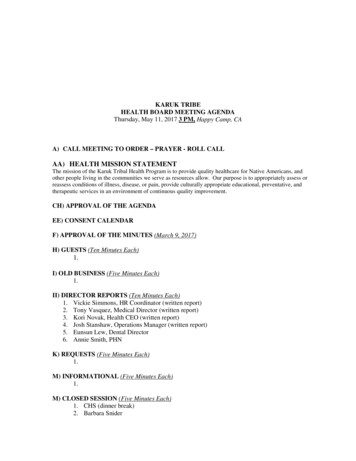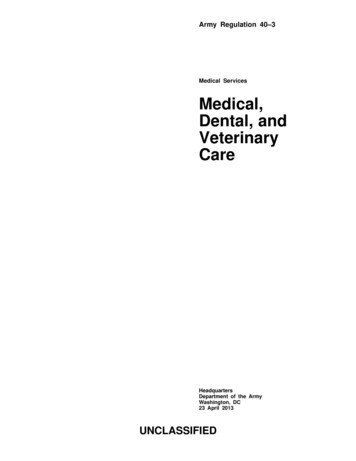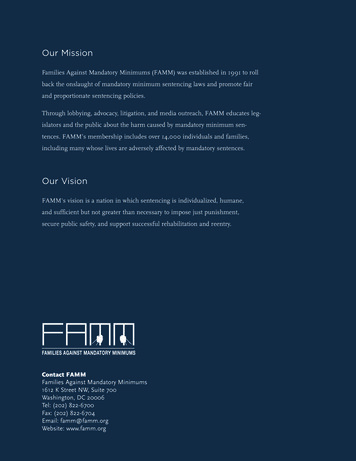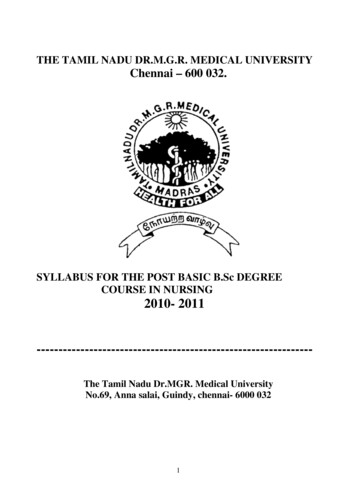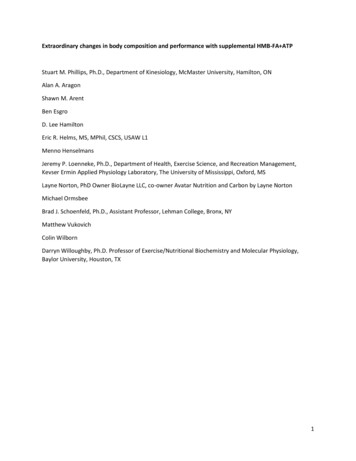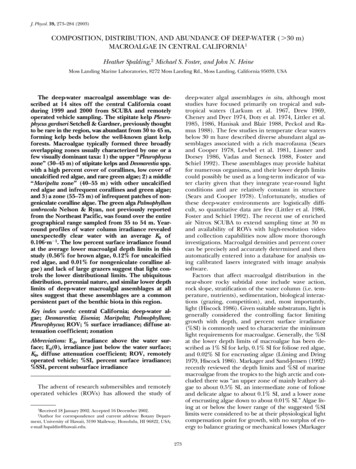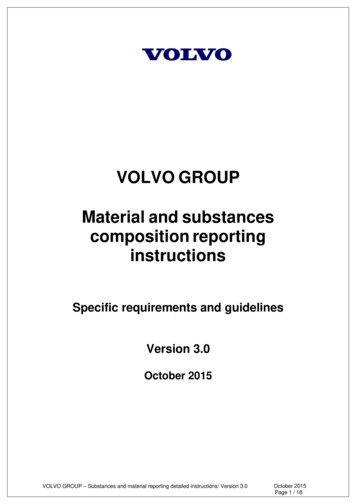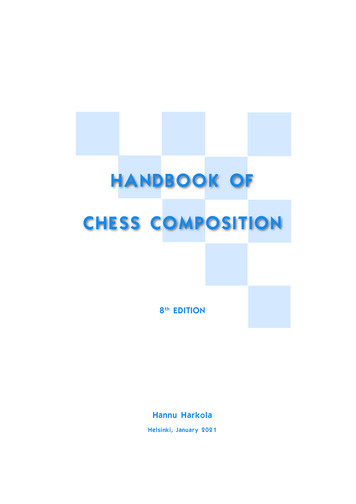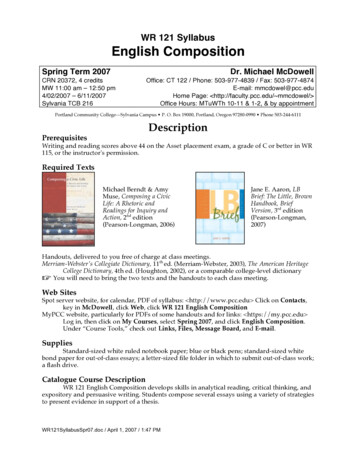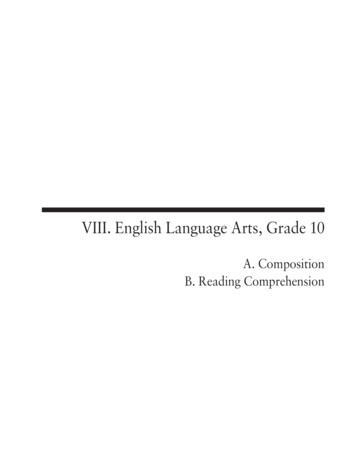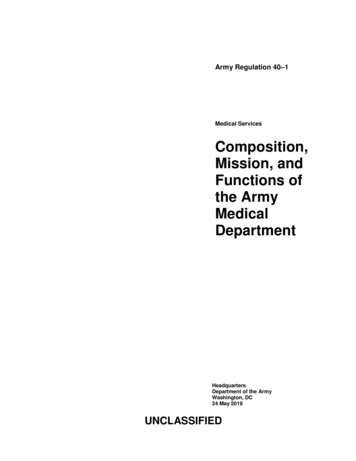
Transcription
Army Regulation 40–1Medical ServicesComposition,Mission, andFunctions ofthe ArmyMedicalDepartmentHeadquartersDepartment of the ArmyWashington, DC24 May 2019UNCLASSIFIED
SUMMARY of CHANGEAR 40–1Composition, Mission, and Functions of the Army Medical DepartmentThis major revision, dated 24 May 2019-oExpands the responsibilities of The Surgeon General (para 1–4a).oClarifies the dual-hat role of The Surgeon General as the Commander, U.S. Army Medical Command (para 1–4a(10)).oClarifies the dual-hat role of the Deputy Surgeon General as the Deputy Commanding General, U.S. Army MedicalCommand (para 1–4b(3)).oExplains the role of the Command Sergeant Major, U.S. Army Medical Command (para 1–4c).oExpands composition of the Army Medical Department, to include the Enlisted Corps and Civilian Corps (paras 1–4dand 1–4e).oUpdates provisions on Army Medical Department command positions (para 1 –9).oAdds responsibilities for consultants to The Surgeon General (para 1–11).oAdds responsibilities for the corps synchronization element members (para 1–12).oAdds a chapter on the corps chiefs’ offices and their functions (chap 2).oMoves warrant officer roles and responsibilities to the corps where they perform duties (chap 2).oAdds authorization information about a Chiropractic Section in the Medical Specialist Corps (para 2–6a(2)).oRefers to all corps consistently, with two-letter designations (throughout).oUpdates information on professional consultants (throughout).oRemoves material that is obsolete due to organizational restructuring (throughout).
HeadquartersDepartment of the ArmyWashington, DC24 May 2019*Army Regulation 40–1Effective 24 June 2019Medical ServicesComposition, Mission, and Functions of the Army Medical DepartmentHistory. This publication is a major revision.Summary. This revision prescribes thecomposition, mission, functions, and responsibilities of the Army Medical Department as authorized under Section 7067, Title 10, United States Code. It implementsDODD 6400.04E, DODD 5101.1, and AR190–17.Applicability. This regulation applies tothe Regular Army, the Army NationalGuard/Army National Guard of the UnitedStates, and the U.S. Army Reserve, unlessotherwise stated.Army internal control process. Thisregulation contains internal control provisions in accordance with AR 11–2 and identifies key internal controls that must beevaluated (see appendix B).Proponent and exception authority.The proponent of this regulation is The Surgeon General. The proponent has the authority to approve exceptions or waivers tothis regulation that are consistent with controlling law and regulations. The proponentmay delegate this approval authority, inwriting, to a division chief within the proponent agency or its direct reporting unit orfield operating agency, in the grade of colonel or the civilian equivalent. Activitiesmay request a waiver to this regulation byproviding justification that includes a fullanalysis of the expected benefits and mustinclude formal review by the activity’s senior legal officer. All waiver requests will beendorsed by the commander or seniorleader of the requesting activity and forwarded through their higher headquarters tothe policy proponent. Refer to AR 25–30for specific guidance.Supplementation. Supplementation ofthis regulation and establishment of command and local forms are prohibited without prior approval from The Surgeon General of the Army (DASG–HSZ), 7700 Arlington Boulevard, Falls Church, VA22042–5142.Suggested improvements. Users areinvited to send comments and suggestedimprovements on DA Form 2028 (Recommended Changes to Publications and BlankForms) directly to The Surgeon General ofthe Army (DASG–HSZ), 7700 ArlingtonBoulevard, Falls Church, VA 22042–5142.Distribution. This regulation is availablein electronic media only and is intended forthe Regular Army, the Army NationalGuard/Army National Guard of the UnitedStates, and the U.S. Army Reserve.Contents (Listed by paragraph and page number)Chapter 1Introduction, page 1Purpose 1–1, page 1References 1–2, page 1Explanation of abbreviations and terms 1–3, page 1Responsibilities 1–4, page 1Records management (recordkeeping) requirements 1–5, page 2Composition 1–6, page 2Mission 1–7, page 3Functions 1–8, page 3Command positions 1–9, page 3Utilization of Army Medical Department Officers 1–10, page 4Consultants to The Surgeon General 1–11, page 4Corps synchronization element 1–12, page 5Organization of the Army Medical Department 1–13, page 5Chapter 2Corps of the Army Medical Department, page 6*This regulation supersedes AR 40-1, dated 1 July 1983.AR 40–1 24 May 2019UNCLASSIFIEDi
Contents—ContinuedMedical Corps 2–1, page 6Dental Corps 2–2, page 7Veterinary Corps 2–3, page 7Medical Service Corps 2–4, page 9Army Nurse Corps 2–5, page 10Army Medical Specialist Corps 2–6, page 112Enlisted Corps 2–7, page 13Civilian Corps 2–8, page 14Chapter 3Offices of the Corps Chiefs, page 14Mission 3–1, page 14Chief, Medical Corps functions 3–2, page 15Chief, Dental Corps functions 3–3, page 17Chief, Veterinary Corps functions 3–4, page 17Chief, Medical Service Corps functions 3–5, page 17Chief, Army Nurse Corps functions 3–6, page 17Chief, Army Medical Specialist Corps functions 3–7, page 18Chief, Enlisted Corps functions 3–8, page 18Chief, Civilian Corps functions 3–9, page 18Hierarchical relationship between The Surgeon General and the corps chiefs 3–10, page 19Chapter 4Corps Specific Branch Proponent Officer, page 20Mission 4–1, page 20Functions 4–2, page 21Organization 4–3, page 21Rating schemes 4–4, page 21Routing and staffing 4–5, page 21Corps specific branch proponent officers’ integration with Army Medical Department and Army elements 4–6, page 22AppendixesA. References, page 23B. Internal Control Evaluation, page 26Figure ListFigure 1–1: Army Medical Department organizational structure, page 5Figure 3–1: Organizational structure for the corps chiefs’ offices, page 20Figure 4–1: Corps-specific branch proponent officer schematic, page 22GlossaryiiAR 40–1 24 May 2019
Chapter 1Introduction1–1. PurposeThis regulation prescribes the composition, mission, functions, and responsibilities of the Army Medical Department(AMEDD), as established under Section 7067, Title 10, United States Code (10 USC 7067). It also provides informationpertaining to the AMEDD and each corps therein.1–2. References and formsSee appendix A.1–3. Explanation of abbreviations and termsSee the glossary.1–4. Responsibilitiesa. The Surgeon General. TSG is a general officer (GO) appointed from any corps of the AMEDD in accordance with10 USC 7036. TSG is the principal advisor to the Secretary of the Army (SECARMY); Chief of Staff, Army (CSA); andother principal officials of Headquarters, Department of the Army (HQDA) on all health and medical matters of the Army,including the medical aspects of manning, training, organizing, and equipping the Army. TSG assists and supports theassistant secretaries of the Army in each of their functional areas of responsibility through the development and executionof Army strategy, policy, and plans related to health affairs; the execution and supervision of those policies and plans byother Army organizations; and assessment of health affairs policies and programs. The Secretary of Defense designatedthe SECARMY as the DOD executive agent for DOD veterinary public-health and animal-health services. The Secretaryof Defense directed the SECARMY to delegate this authority to The Surgeon General. In AR 190–17, the Secretary of theArmy designates TSG as the executive agent responsible official for the DOD Biological Select Agent and Toxins Biosafety Program. TSG also serves as the chief medical advisor of the Army to the Director of the Defense Health Agency(DHA) on matters pertaining to military health readiness requirements and safety of members of the Army. In addition,TSG—(1) Executes the development, policy direction, organization, and overall management of an integrated Armywide system of health in a manner consistent with the implementation of DHA’s responsibility for administering each militarymedical treatment facility (MTF), in accordance with 10 USC 1073c.(2) In accordance with 10 USC 7036, and acting under the authority, direction, and control of the SECARMY, willrecruit, organize, train, and equip medical personnel of the Army.(3) Represents the Army on health policies both inside and outside the Department of Defense (DOD), including to theU.S. Department of Veterans Affairs, the White House and other elements of the executive branch, Congress, and nongovernmental organizations.(4) Provides technical advice and assistance to the Army Secretariat and Army Staff on matters regarding health readiness of the force; warrior transition care; public health; medical force structure and equipping; force development; medicalresearch and development; test and evaluation of medical systems; medical training and education; medical evacuation;and medical military construction.(5) Develops and directs the Army's planning, programming, budgeting, and execution process for the Defense HealthProgram.(6) Advises on the medical aspects of maintaining a physically and mentally fit, combat and operationally ready, militaryforce.(7) Ensures the timely availability of trained personnel and other health resources required to provide support to approved combat, mobilization, and contingency plans of the Army.(8) Provides a program of health services to all eligible beneficiaries as currently authorized by law and practice.(9) Maintains a professionally viable and effective Army healthcare system that is an incentive for recruiting and retaining high-quality health professionals in an all-volunteer Army.(10) Is dual-hatted as the Commander, U.S. Army Medical Command (MEDCOM), in accordance with AR 10–87.(11) Ensures that AMEDD officers and civilians who are members of the Army acquisition work force comply withPublic Law 101–510 (The Defense Acquisition Workforce Improvement Act), as modified by 10 USC Chapter 87.b. The Deputy Surgeon General. The DSG is a GO of the AMEDD who—(1) Performs duties assigned by TSG.AR 40–1 24 April 20191
(2) Serves as acting TSG in the TSG’s temporary absence, as well as any absence due to death, disability, retirement,reassignment, or expired term of office.(3) Is dual hatted as the Deputy Commanding General (Support), MEDCOM.c. The Command Sergeant Major. The CSM —(1) Serves as principal advisor to TSG on all AMEDD enlisted-personnel matters.(2) Helps TSG plan, direct, and supervise healthcare delivery and services for the Army as pertains to AMEDD enlistedpersonnel.(3) Consults and coordinates on policies and standards pertaining to performance, care, conduct, appearance, personnelmanagement, and training of AMEDD’s enlisted personnel.(4) Helps inspect command activities, facilities, and personnel to include but not limited to assessing readiness, qualityof life, and training of AMEDD’s enlisted personnel as prescribed by TSG.(5) Represents, or appoints a representative, as president or member of command promotion boards for noncommissioned officers as authorized by regulations.(6) Ensures effective career planning and training are provided to AMEDD’s enlisted personnel to achieve professionaland educational goals and opportunities.(7) Monitors professional quality, performance, and career development of AMEDD enlisted personnel, in their respective specialties, to ensure the highest standards of healthcare delivery and service.(8) Monitors development and implementation of AMEDD’s enlisted-personnel education and training programs tosupport readiness requirements of the AMEDD.(9) Provides guidance on plans and policies for management, training, and utilization of AMEDD’s enlisted personnel.(10) Ensures that officers commissioned in the Medical Corps (MC), Dental Corps (DC), Veterinary Corps (VC), Medical Service Corps (MS), Army Nurse Corps (AN), and Army Medical Specialist Corps (SP) of the AMEDD will carryout the duties outlined in chapter 2.(11) Ensures that warrant officers assigned to AMEDD specialties will carry out the duties outlined in chapter 2.d. Enlisted personnel overview.(1) TSG has designated an Enlisted Corps (EC) to recognize the integral role of enlisted personnel in supporting theArmy medicine mission.(2) Active duty AMEDD enlisted personnel will be placed in positions consistent with their primary military occupationspecialties (MOSs) or career progression MOS qualifications, in accordance with AR 614–200.(3) Army National Guard of the United States and U.S. Army Reserve (USAR) enlisted personnel will be utilized inpositions equal to their military qualifications and personal attributes.(4) Enlisted personnel assigned to AMEDD specialties fulfill the roles outlined in chapter 2.e. Civilian personnel overview.(1) TSG has designated a Civilian Corps (CC) to recognize the integral role of civilian personnel to support the Armymedicine mission.(2) The AMEDD CC consists of U.S. citizens, direct-hire, and indirect-hire local nationals employed under appropriateregulations of the U.S. Office of Personnel Management (OPM), HQDA, and the AMEDD.1–5. Records management (recordkeeping) requirementsThe records management requirements for all record numbers, associated forms and reports required by this regulationare addressed in the Army Records Retention Schedule–Army (RRS–A). Detailed information for all related recordnumbers, forms, and reports are located in ARIMS/RRS–A at https://www.arims.army.mil. If any record numbers,forms, and reports are not current, addressed, and/or published correctly in ARIMS/RRS–A, see DA Pam 25–403 forguidance.1–6. Compositiona. The AMEDD encompasses those Army special branches that are under the supervision and management of TSG andare established in 10 USC 7067. Specifically, these special branches are the MC, DC, VC, MS, AN, and SP. In addition tothese statutorily established corps, TSG has designated the EC and CC to recognize the integral role of enlisted and civilianpersonnel in supporting the AMEDD mission. The separate nature of the many disciplines within the branches comprisingthe total healthcare delivery system dictates diversity in the approach to managing personnel within that system. Althoughseparate and unique, the branches cannot effectively function apart from one another, due to the commonality created bythe mission.b. The AMEDD is one of the world’s largest health systems and includes all roles of medical, dental, veterinary, andother related healthcare, from policy and decision making to the combat medic in the field. The AMEDD is composed of2AR 40–1 24 April 2019
its execution elements; the Office of The Surgeon General (OTSG), a principal office of the Army Staff; and MEDCOM,a direct reporting unit (DRU) to HQDA.1–7. Missiona. The mission of the AMEDD is to maintain the health of the Army and conserve its fighting strength. Care is providedfor eligible personnel in peacetime and, at the same time, preparations are made for health support of the Army in time ofwar, international conflict, or natural disaster. Successfully accomplishing the AMEDD mission relies on teamwork amongall health professionals while providing optimum healthcare and services to Soldiers, their Families, and other beneficiaries.b. Accomplishing this mission requires the following—(1) Developing and executing coordinated plans and programs to provide the best possible health service, in war andpeace, to eligible personnel.(2) Establishing health standards.(3) Selecting medically fit personnel for military service and disposition of the medically unfit.(4) Applying effective means of public-health and preventive-medicine services.(5) Applying effective means of health education and management.(6) Executing an approved medical research, development, test, and evaluation program.1– 8. FunctionsThe four major functions of the AMEDD are—a. Selecting physically and mentally fit persons for military service.b. Identifying and mitigating threats to the health and well-being of Soldiers, their Families, and other beneficiariesthrough robust holistic health promotion, wellness, preventive medicine, and environmental programs.c. Medically treating those who become sick or injured, and promptly returning them to duty or other disposition asappropriate.d. Promptly evacuating patients from the combat zone to MTFs designated to provide the type and extent of treatmentrequired.81–9. Command positionsa. The provisions of AR 600–20 apply in designating or assuming command within the AMEDD, except as modified inthis regulation.b. AMEDD commands include regional health commands (RHCs), medical centers (MEDCENs), medical departmentactivities (MEDDACs), Army health clinics, public health regional commands (PHRCs), public health activities (PHAs),dental health commands (DHCs), the U.S. Army Medical Department Center and School (AMEDDC&S) and U.S. ArmyHealth Readiness Center of Excellence (HRCoE), U.S. Army Medical Research and Material Command (MRMC), andAMEDD table of organization and equipment (TOE) units designated by HQDA. These medical units will be commandedby AMEDD officers eligible to assume command under AR 600–20. This includes all AMEDD commands, regardless ofArmy command, Army service component command, or DRU task organization. The designated AMEDD officer willcommand these medical units, even though another officer may be the senior officer assigned. DA Pam 600–4 outlinesAMEDD commander-selection processes.(1) Regional health command. An RHC is a regional command element that oversees the day-to-day operations ofMEDCENs; MEDDACs; Army health clinics, DHCs; PHRCs; PHAs, and numerous clinics throughout the United States,Europe, and Asia. The RHCs include Atlantic, Central, Europe, and Pacific sites.(2) Non-command health clinics. Those health clinics not designated as a command will remain an organizational element of their MEDCEN or MEDDAC; the parent organization is responsible for administrative control (ADCON) overpersonnel and financial resources. The parent MEDCEN or MEDDAC commander will provide the professional direction,in addition to selecting the officer-in-charge to manage the day-to-day clinic activities.(3) Public health regional command. A PHRC is a regional command element that promotes the health of people,communities, animals, and work places by preventing disease, injury, and disability of Soldiers, military retirees, theirFamilies, DA Civilian employees, and animals through studies, surveys, assistance visits, and technical consultation withintheir region. The PHRC commanders will exercise command authority over personnel assigned to all PHAs within theirregion.(4) Public health activity. A PHA is a command activity subordinate to a respective PHRC. The PHA commander willexercise command authority over personnel assigned to their installations and provide the highest quality animal medicalcare, comprehensive food safety and quality assurance, and veterinary preventive medicine support possible.AR 40–1 24 April 20193
(5) Dental Corps officer. Under 10 USC 7081(d), dental and dental auxiliary personnel throughout the Army are organized into units commanded by a designated Dental Corps officer.(6) Dental health command. Professional direction of regional DHCs will come from the regional health commanders.The DHC will be commanded by a DC officer. The DHC commander will exercise command authority over personnelassigned to all dental activities (DENTACs) within the region, in accordance with AR 600–20.(7) Dental health activity. Command and professional direction of DENTACs will come from the DHC commander.DENTACs are subordinate to a specified DHC and commanded by a DC officer. The DENTAC commander may exercisecommand authority over personnel assigned to other installations. This may include a dental c
(10) Ensures that officers commissioned in the Medical Corps (MC), Dental Corps (DC), Veterinary Corps (VC), Med-ical Service Corps (MS), Army Nurse Corps (AN), and Army Medical Specialist Corps (SP) of t
